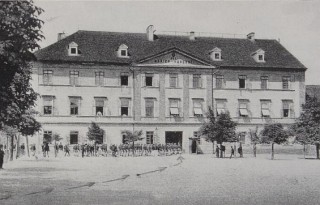
Mariánská kasárna in CB (Budweis). Until 1 June 1915 it was the home of the Good Soldier Švejk's Infanterieregiment Nr. 91. In 1915 Jaroslav Hašek also served with the regiment in these barracks.
The novel The Good Soldier Švejk refers to a number of institutions and firms, public as well as private. On these pages they were until 15 September 2013 categorised as 'Places'. This only partly makes sense as this type of entity can not always be associated with fixed geographical points, in the way that for instance cities, mountains and rivers can. This new page contains military and civilian institutions (including army units, regiments etc.), organisations, hotels, public houses, newspapers and magazines.
The line between this page and "Places" is blurred, churches do for instance rarely change location, but are still included here. Therefore Prague and Vienna will still be found in the "Places" database, because these have constant coordinates. On the other hand institutions may change location: Odvodní komise and Bendlovka are not unequivocal geographical terms so they will from now on appear on this page.
The names are colour coded according to their role in the plot, illustrated by these examples: U kalicha as a location where the plot takes place, k.u.k. Kriegsministerium mentioned in the narrative, Pražské úřední listy as part of a dialogue, and Stoletá kavárna, mentioned in an anecdote.
 Institutions index of institutions, taverns, military units, societies, periodicals ... (288)
Show all
Institutions index of institutions, taverns, military units, societies, periodicals ... (288)
Show all I. In the rear
I. In the rear  14. Švejk as military servant to senior lieutenant Lukáš (14)
14. Švejk as military servant to senior lieutenant Lukáš (14) II. At the front
II. At the front  1. Švejk's mishaps on the train (15)
1. Švejk's mishaps on the train (15) 2. Švejk's budějovická anabasis (38)
2. Švejk's budějovická anabasis (38) 3. Švejk's happenings in Királyhida (44)
3. Švejk's happenings in Királyhida (44) 4. New afflictions (26)
4. New afflictions (26)



|
III. The famous thrashing |
 | |
3. From Hatvan to the borders of Galicia | |||
 | U Rozvařilů |  | |||
| Praha II./1047, Na Pořící 24 | |||||
| |||||
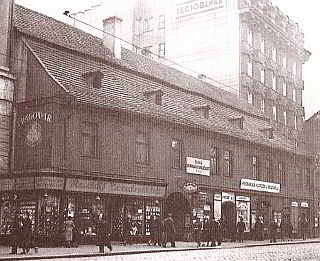
U Rozvařilů is mentioned in the anecdote about Oberst Fliedler.
Background
U Rozvařilů was a brewery and restaurant at Pořící, also offering entertainment in the form of concerts.
The enterprise still exists (2010), albeit in another form: as a restaurant in the department store Bílá Labuť. The original building has obviously been demolished.
Quote(s) from the novel
[III.3] Železnýmu už to bylo všechno jedno. Tak jak šli přes Poříč, kolem Rozvařilů, Železný skočil do průjezdu a ztratil se mu průchodem a zkazil Kaučukovýmu dědkovi tu velikou radost, až ho bude sázet do arestu.
Literature
- Románové restaurační a jiné zábavní podniky, ,2009 - 2021
 | U Bucků |  | |||
| Praha II./1046, Na Pořící 22 | |||||
| |||||
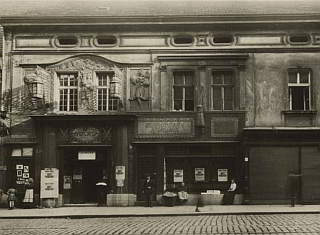
U Bucků is mentioned in the anecdote about Oberst Fliedler.
Background
U Bucků was a brewery with restaurant at Pořící in Prague, next door to U Rozvařilů.
Quote(s) from the novel
[III.3] Až takhle jednou vod našeho regimentu podařilo se jednomu probodnout jednoho dragouna v hospodě ,U Bucků’, kterej mu chodil za holkou, a tu nás seřadili do čtverce, museli vyjít všichni, i marodka, kdo byl moc marod, toho dva drželi.
Literature
- Románové restaurační a jiné zábavní podniky, ,2009 - 2021
- Nejstarří zpevní síň, ,6.2.1896
 | Šimáček |  | |||
| |||||
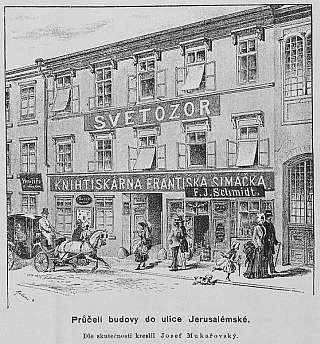
Šimáček is indirectly mentioned by Leutnant Dub who points to a melodramatic article about the killings Sarajevo in the magazine publisher Šimáček's Four-leaved Clover from July 1914.
Background
Šimáček was a Czech publishing house founded by František Šimáček in 1856. In 1914 it was managed by Bohuslav Šimáček. They published the illustrated magazine Šimáčkův čtyřlístek which is referred to in The Good Soldier Švejk. The magazine appeared twice a month. The company was located in Jerusalémská ulice in Nové město.
Quote(s) from the novel
[III.3] Nadporučík Lukáš jen zamručel k sobě, že asi zde v Humenném četníci odebírali Šimáčkův Čtyřlístek s tím dojemným článkem. Vůbec se mu počalo vše najednou hnusit a cítil jenom potřebu opít se, aby ho opustil světobol. Vyšel tedy z vagonu a šel vyhledat Švejka.
 | Vilímek |  | |||
| |||||
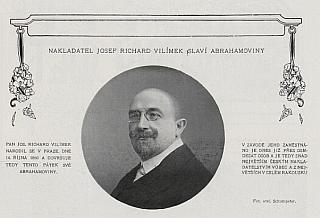
,14.10.1910
Vilímek is mentioned by Einjährigfreiwilliger Marek when he refers to their magazine The Illustrated War Correspondent and their material from the Russo-Japanese war of 1904-1905.
Background
Vilímek was a Czech publishing house founded in 1858 by Josef Richard Vilímek (1835-1911). His identically named son (1860-1938) took over in 1886 and they became on of the three largest publishers in the Bohemia and later in Czechoslovakia.
The company was nationalised and closed after the Communist coup in 1948. It briefly re-emerged as a brand-name after the 1989 revolution, only to disappear in a privatisation scandal.
The magazine mentioned, Ilustrovaný válečný zpravodaj is not listed in the catalogue of the Czech National Library so the author surely had Obrazový zpravodaj z bojiště in mind. It was printed by Unie in 1904-1905 and edited by Jan Klecanda (1855-1920), the father of explorer Havlasa.
Quote(s) from the novel
[III.3] Zajímavé bude, jak náš batalion přepadne spícího nepřítele, k čemuž ovšem je potřeba slohu ,Ilustrovaného válečného zpravodaje’, který vycházel u Vilímka za rusko-japonské války.
Credit: Sergey Soloukh
Literature
- Obrazový zpravodaj z bojiště, ,1904-05
- Jos. R. Vilímek st., ,18.4.1911
- Historie nakladatelství Josef R. Vilímek,
- Trampoty pana Tenkráta, ,1912
 | Na zastávce |  | |||
| Královské Vinohrady/713, Palackého tř. 78 | |||||
| |||||
Na zastávce was one of the pubs where gardener Kalenda made a stop on his world tour. A pub with the same name is mentioned again in the next chapter in the anecdote about the construction site foreman who was not to drink alcohol.
Background
Na zastávce was seemingly a pub in Vinohrady. It is most probably referred to a pub in Palackého třída 713, now Franczouska. There were nevertheless two other pubs with this name in Prague but none of them fit the route of gardener Kalenda.
Quote(s) from the novel
[III.3] Strašnickej zahradník, nějakej Josef Kalenda, ten se taky jednou vzdálil z domova, šel ze Strašnic na Vinohrady, stavil se ,Na zastávce’ v hospodě, ale to mu ještě nic nebylo, ale jakmile přišel do Korunní třídy k vodárně, bral v Korunní třídě až za kostel svaté Ludmily hospodu za hospodou a cítil už malátnost.
 | Vinohradská vodárna |  | |||
| |||||
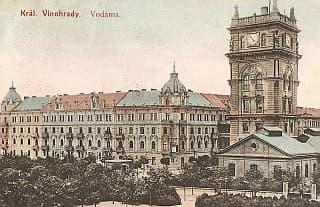
Vinohradská vodárna, 1905
Vinohradská vodárna was the place where gardener Kalenda started to enter pubs on his way around the world.
Background
Vinohradská vodárna is a former water tower in Korunní třída, a neo-renaissance building finished in 1891.
Quote(s) from the novel
[III.3] Strašnickej zahradník, nějakej Josef Kalenda, ten se taky jednou vzdálil z domova, šel ze Strašnic na Vinohrady, stavil se ,Na zastávce’ v hospodě, ale to mu ještě nic nebylo, ale jakmile přišel do Korunní třídy k vodárně, bral v Korunní třídě až za kostel svaté Ludmily hospodu za hospodou a cítil už malátnost.
 | Kostel svaté Ludmily |  | |||
| |||||

Pohled na náměstí Míru s kostelem sv. Ludmily s parkovou úpravou (kol. 1900)
Kostel svaté Ludmily is amongst the many places mentioned in Švejk's long anecdote about gardener Kalenda. He walked past this church on his world tour.
Background
Kostel svaté Ludmily is a twin-spired, neo-gothic church at Náměstí míru in Vinohrady that was opened in 1893. Jaroslav Hašek married Jarmila Mayerová here on 23 May 1910.
Quote(s) from the novel
[III.3] Strašnickej zahradník, nějakej Josef Kalenda, ten se taky jednou vzdálil z domova, šel ze Strašnic na Vinohrady, stavil se ,Na zastávce’ v hospodě, ale to mu ještě nic nebylo, ale jakmile přišel do Korunní třídy k vodárně, bral v Korunní třídě až za kostel svaté Ludmily hospodu za hospodou a cítil už malátnost.
 | U remisy |  | |||
| Královské Vinohrady/107, Jungmannova tř. - | |||||
| |||||

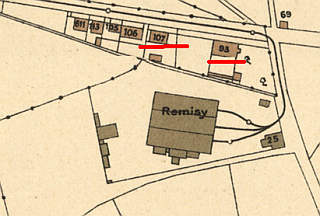
Map from 1911
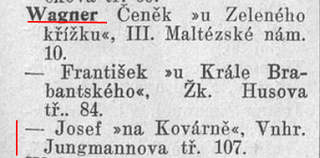
U remisy was the pub where gardener Kalenda from Švejk's anecdote made a bet with a tram driver from that he could walk around the earth in three weeks.
Background
U remisy was apparantly a pub in Strašnice, to judge by the name near a tram depot (vozovna). There is a tram depot in Strašnice still, located in Vinohradská třída. It was opened in 1908 and was the oldest of its kind in Prague.
In 1910 there were three taverns close to the tram depot, two of them next door at Jungmannová třida 93 and 107. The landlords were Josef Šmíd and Josef Wagner respectively. Both are listed as na Kovárně but may still have been known as "U remisy" in day to day speak. The exact identification is therefore difficult, but Wagner's pub is probably the best bet as he is the only one listed in the address book for Vinohrady from 1912.
Note that the border between Strašnice and Vinohrady went between the tram depot and the two pubs but Švejk would probably not have been aware of this fine distinction.
A restaurant with the same name in the same place still existed in 2010 although the address was very different both with respect to street names and house numbering.
Quote(s) from the novel
[III.3] Nedal se však tím odstrašit, poněvadž se vsadil předtím ten večer v Strašnicích v hospodě ,U remisy’ s jedním řídičem vod elektriky, že udělá pěšky cestu kolem světa za tři neděle. Počal se tedy dál a dál vzdalovat vod svýho domova, až se přivalil do ,Černýho pivovaru’ na Karlově náměstí, a vodtamtuď šel na Malou Stranu k Sv. Tomáši do pivovaru a odtamtud přes restauraci ,U Montágů’ a ještě vejš přes hospodu ,U krále brabanskýho’, pak na ,Krásnou vyhlídku’, odtud do Strahovskýho kláštera do pivovaru.
 | Černý pivovar |  | |||
| Praha II./292, Karlovo nám. 15 | |||||
| |||||

Černý pivovar was one of the pubs gardener Kalenda dropped by on his legendary pub crawl (world tour).
Background
Černý pivovar (Black Brewery) was a brewery and restaurant with address Karlovo náměstí 15. In 1891 it was registered in the name of František Fiala and was operating until 1920.
In 1934 the restaurant re-opened in the new building constructed on the site but we don't know when it closed down again. The bulding still exists but has an entirely different function.
Quote(s) from the novel
[III.3] Počal se tedy dál a dál vzdalovat vod svýho domova, až se přivalil do ,Černýho pivovaru’ na Karlově náměstí, a vodtamtuď šel na Malou Stranu k Sv. Tomáši do pivovaru a odtamtud přes restauraci ,U Montágů’ a ještě vejš přes hospodu ,U krále brabanskýho’, pak na ,Krásnou vyhlídku’, odtud do Strahovskýho kláštera do pivovaru.
Credit: Jaroslav Šerák
Also written:Black BreweryenSchwarze BrauereideSvarte Bryggerino
Literature
- Románové restaurační a jiné zábavní podniky, ,2009 - 2021
- Adresář hlavního města Prahy, ,1936
 | U svatého Tomáše |  | |||
| Praha III./28, Letenská ul. 20 | |||||
| |||||
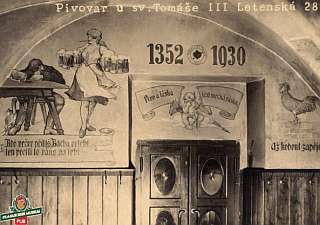
U svatého Tomáše was one of the pubs gardener Kalenda dropped by.
Background
U svatého Tomáše was a restaurant and brewery in Malá Strana, known for their dark beer. It was one of the oldest breweries in Bohemia but closed in 2006 when the building was converted to a hotel.
Quote(s) from the novel
[III.3] Počal se tedy dál a dál vzdalovat vod svýho domova, až se přivalil do ,Černýho pivovaru’ na Karlově náměstí, a vodtamtuď šel na Malou Stranu k Sv. Tomáši do pivovaru a odtamtud přes restauraci ,U Montágů’ a ještě vejš přes hospodu ,U krále brabanskýho’, pak na ,Krásnou vyhlídku’, odtud do Strahovskýho kláštera do pivovaru.
 | U Montágů |  | |||
| Praha III./6, Malostranské nám. 19 | |||||
| |||||
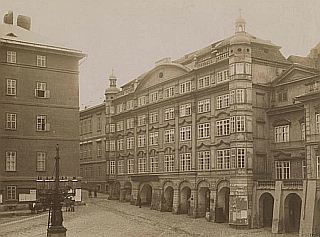
U Montágů was one of the pubs gardener Kalenda dropped by.
Background
U Montágů was a restaurant at Malostranské náměstí which in 1891 and even as late as 1910 was owned by Antonín Janda. The building U Montágů still exists but is better known by the name Palác Smiřických. It is a part of the building complex that is used as a seat of the Chamber of Deputies of the Czech Parliament. Note that the pub was in the next building down, also known as Šternberský palác.
Quote(s) from the novel
[III.3] Počal se tedy dál a dál vzdalovat vod svýho domova, až se přivalil do ,Černýho pivovaru’ na Karlově náměstí, a vodtamtuď šel na Malou Stranu k Sv. Tomáši do pivovaru a odtamtud přes restauraci ,U Montágů’ a ještě vejš přes hospodu ,U krále brabanskýho’, pak na ,Krásnou vyhlídku’, odtud do Strahovskýho kláštera do pivovaru.
Credit: Jaroslav Šerák
 | U krále brabantského |  | |||
| Praha III./198, Thunovská ul. 15 | |||||
| |||||
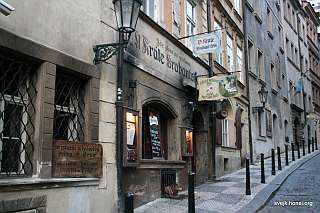
U krále brabantského, 2011

Ladislav Hájek, 1925
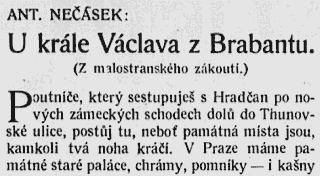
Humoristické listy, 27.8.1915
U krále brabantského was one of the eight named pubs that gardener Kalenda visited on his world tour which ended up as a gigantic pub-crawl.
It was also probably here that Blahník and Švejk planned the dog-theft in [I.14]. See Malý výčep piva and Zámecké schody.
Background
U krále brabantského is one of the oldest existing pubs in Prague, now (2010) part of a chain which uses the Medieval times as a theme. According to their web page it was opened as early as 1375 and has been operating almost continuously ever since.
Hašek and the King of Brabant
Hájek provides a number of details about the establishment, and describes his visits there with Hašek, Opočenský, Lada a.o. He remembers the entertaining landlord Krügler, a former regiment musician. The landlord was good at whistling and playing drums with his fingers. He also entertained his guests with his story telling.
In one of the stories Krüger claims it that a former landlord murdered a guest who defrauded him and dumped the body in the underground sever on the street. The body, with the head down the sever and feet sticking up, was only found further down the street when the sewer flooded a few days later. This grotesque tale was one of Hašek's favourites.
Another story that Hašek also liked was about a group of schoolchildren from the countryside who were treated by the landlord to beer and sausages. They thanked the landlord by singing, although he would rather have been paid! This story was eventually published by Antonín Nečásek in Humoristické listy.
In the end Hájek and his friends stopped going there after Hašek caused an outrage by tearing apart a painting of king Václav IV.
Used for secret meetings
Sergey Soloukh points to an important note by Zdeněk Matěj Kuděj in his book Ve dvou se to lépe táhne. Kuděj describes the tavern as dark and dingy, popular for secret meetings. This information alone makes the pub a good candidate as host for the conspirational meeting between Švejk and Blahník in the novel.
Landlords

Věstník obecní královského hlavního města Prahy, 13.7.1912
The address books show that the landlord in 1891 was František Simáček, and in 1907 and 1910 a Josef Král ran the bar. He was succeeded by Emanuel Klucker (born in Graz in 1867) who on 4 July 1912 was granted a license by the city magistrate to serve alcohol at the premises.
Klucker was a colourful character with a background as regiment musician, vividly described by Antonín Nečásek in Humoristické listy in 1915. His tavern struggled in the beginning but already by 1915 it was thriving. Klucker (also written Kluker) was definitely the landlord "Krügler" that Hájek described. Klucker was not new in the restaurant business: in 1907 he was running U Pavlanských at Újezd 25, also in Malá Strana.
Murder
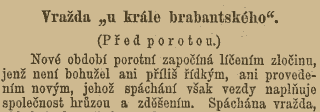
,18.5.1885

,16.12.1884
The murder that Klucker describes (as retold by Hájek) took place in the early hours of 10 December 1884, but the victim was landlord Václav Petráň, not a guest. He was robbed and in the resulting fight he was suffocated. The body was thrown into the sewers outside the pub and discovered a few days later during a flood.
The murderer Antonín Hrdlička was arrested four days later and put on trial in May 1885. The case was heard for two days and the verdict fell on 19 May 1885. Hrdlička was sentenced to death by hanging but on 11 July the sentence was converted to life imprisonment through an imperial decree. The case was widely reported in newspapers across Austria.
Quote(s) from the novel
[III.3] Počal se tedy dál a dál vzdalovat vod svýho domova, až se přivalil do ,Černýho pivovaru’ na Karlově náměstí, a vodtamtuď šel na Malou Stranu k Sv. Tomáši do pivovaru a odtamtud přes restauraci ,U Montágů’ a ještě vejš přes hospodu ,U krále brabanskýho’, pak na ,Krásnou vyhlídku’, odtud do Strahovskýho kláštera do pivovaru.
Credit: Sergey Soloukh, Ladislav Hájek
Also written:U krále brabanskýhoŠvejk
Literature
- Hostinec opředený mnoha bájemi a legendami,
- Швейк. Время 3. Шаг 7,
- Pobytové přihlášky pražského policejního ředitelství, ,1851 - 1914
- U krále Václava z Brabantu, ,27.8.1915
- Z mých vzpomínek na Jaroslava Haška, ,1925
- Adressář královského hlavního města Prahy,
- Adresář královského hlavního města Prahy a obcí sousedních, ,1907
- Ein Vermißter, ,11.12.1884
- Loupežná vražda v Praze, ,15.12.1884
- Der Raubmord in den Thun'schen Gasse, ,18.5.1885
- Vražda "u krále brabantského", ,18.5.1885
- Vražda "u krále brabantského", ,19.5.1885
- Vražda "u krále brabantského", ,20.5.1885
- Begnadigt, ,12.7.1885
- Dostal milost, ,12.7.1895
- Věstník obecní královského hlavního města Prahy, ,13.7.1912
 | Strahovský klášter |  | |||
| |||||
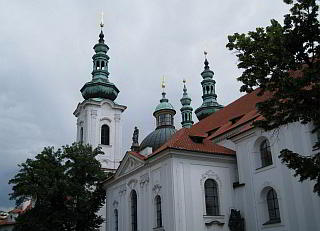
Strahovský klášter is mentioned because gardener Kalenda popped into the monastery brewery just before homesickness overwhelmed him.
Background
Strahovský klášter (Strahov Monastery) is a monastery on the Strahov Hill in Prague and one of the Czech capitals many beautiful landsmarks. It is situated in the Hradčany area, not far from the castle itself. It belongs to the Premonstratensians order and was founded around 1140.
Quote(s) from the novel
[III.3] Počal se tedy dál a dál vzdalovat vod svýho domova, až se přivalil do ,Černýho pivovaru’ na Karlově náměstí, a vodtamtuď šel na Malou Stranu k Sv. Tomáši do pivovaru a odtamtud přes restauraci ,U Montágů’ a ještě vejš přes hospodu ,U krále brabanskýho’, pak na ,Krásnou vyhlídku’, odtud do Strahovskýho kláštera do pivovaru.
Also written:Strahov MonasteryenKloster StrahovdeStrahovklosteretno
 | Strahovský pivovar |  | |||
| Praha IV./135, Strahovské nádvoří 10 | |||||
| |||||

Strahovský pivovar, 1867

,1.12.1900

,20.1.1910
Strahovský pivovar was the final stop on the odyssey of gardener Kalenda, before homesickness got the better of him down at Loretánské náměstí.
Background
Strahovský pivovar was a brewery and restaurant that appeared to have closed down some time before 1919, and is listed in the address books at least from 1870 to 1910. Beer has been brewed on the site at least since the 15th century, although not continuously.
Before the First World War
Tenant from 1896 to 1908 was Jan Řezníček (born 1841) and he was also the last ever brew master to make beer on the monastery premises in the 20th century. In 1899 the production volume was 2,304 hectolitres. In a speech at the 1908 Jubilee exhibition in Prague Řezníček informed that the brewery had been operating since 1780.
The brewery ceased operation in the autumn of 1908 and Řezníček took on a similar position in Stará Boleslav. In 1910 the restaurant part was re-opened after refurbishment but now with beer from the Smíchov brewery and František Švancar as landlord.
New beginning
In 2000 a microbrewery with restaurant called Klášterní pivovar Strahov was established on the same site but has no connection with the old brewery.
Quote(s) from the novel
[III.3] Počal se tedy dál a dál vzdalovat vod svýho domova, až se přivalil do ,Černýho pivovaru’ na Karlově náměstí, a vodtamtuď šel na Malou Stranu k Sv. Tomáši do pivovaru a odtamtud přes restauraci ,U Montágů’ a ještě vejš přes hospodu ,U krále brabanskýho’, pak na ,Krásnou vyhlídku’, odtud do Strahovskýho kláštera do pivovaru.
Literature
- Autentický ukazatel ulic a náměstí i čísel domovních král. hl. města Prahy, 1870,
- Adressář královského hlavního města Prahy a sousedních obcí, 1884,
- Personalien, ,15.3.1896
- Z kruhů pivovarnických, ,17.3.1896
- Biererzeugung Böhmens im Jahre 1899, ,1.12.1900
- Pivovarství na pražské vystavě 1908, ,20.7.1908
- Die Brauindustrie auf der Prager Ausstellung 1908, ,20.7.1908
- Nájmy, ,1.9.1908
- Kassierte Brauereien, ,10.12.1908
- Zrušené pivovary, ,10.12.1908
- Personalnachrichten, ,5.12.1911
- Soupis pražských domovských příslušníků 1830-1910 (1920),
- Historie pivovaru,
 | Odkolek |  | |||
| |||||

Zmizelá Praha sv.5, 1919
Odkolek and the fire at their mills are mentioned by Švejk in his sleep when he slept away the effects of the bottle of cognac at the station in Humenné.
Background
Odkolek was a flour mill and bakery which was founded by František Odkolek in 1850. The fire referred to happened in 1896, and it was the original mill at Kampa that burnt down.
It was not reconstructed, a new mill was built at Vysočany instead. The factory is now owned by United Bakeries. The old mill has since been rebuilt and today it houses Muzeum Kampa.
Quote(s) from the novel
[III.3] Jednoroční dobrovolník začal budit Švejka. „Švejku, hoří, vstávej!“ „Když tenkrát hořely Odkolkovy mlejny,“ zabručel Švejk, obraceje se opět na druhý bok, „přijeli hasiči až z Vysočan...“
Literature
 | Polevkové ústav města Prahy |  | |||
| |||||
Polevkové ústav města Prahy is mentioned by Švejk during a discussion on Einjährigfreiwilliger Marek's invented story about Rechnungsfeldwebel Vaněk's glorious death. This scene took place on the train just before Sanok.
Background
Polevkové ústav města Prahy (Soup institute of the city of Prague) has sureley been a municipal institution that ran soup kitchens, but further information is not available.
Jaroslav Hašek also wrote a short story called Polevkový ústav, which might reveal more information.
Quote(s) from the novel
[III.3] „Moh to ten náš nebožtík,“ řekl Švejk, „vodevzdat polívkovýmu ústavu města Prahy, ale takhle je to přeci jen lepší, von by si třeba pan starosta za ten vobnos koupil jitrnici na gábl.“
Also written:Soup institute of the city of PragueenSuppenanstalt der Stadt Pragde



|
III. The famous thrashing |
 | |
3. From Hatvan to the borders of Galicia | |||
| © 2008 - 2024 Jomar Hønsi | Last updated: 20.11.2024 |


